Volzhskaya "Sultana"
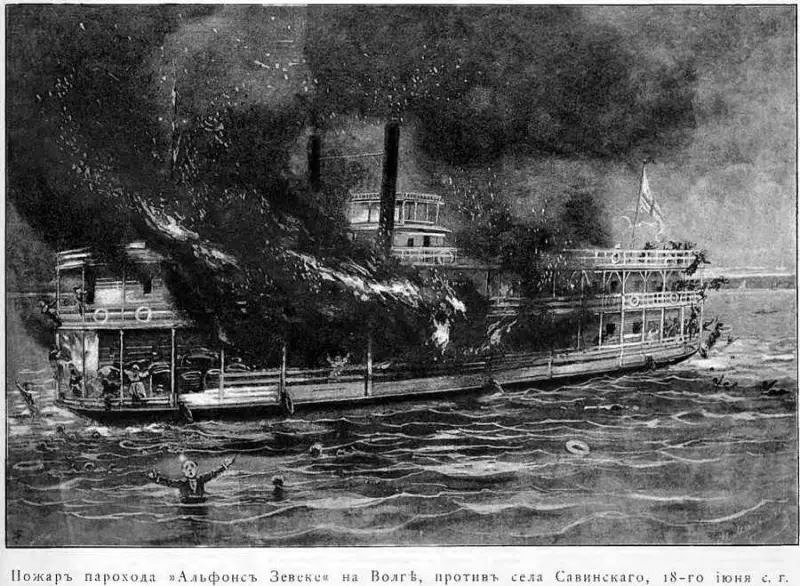
Fire on the ship Alphonse Seeweke. Drawing by M. E. Malyshev, published in the magazine “World Illustration” in 1893, No. 1277, July 10, pp. 49-51
Anacharsis the Scythian, son of King Gnur, brother of King Savlius and Kaduit
Disasters on the waters. On March 21, 2018, an interesting material “Sultana on Fire” about the sinking of an American steamship on the Mississippi in 1865 appeared on the pages of VO. Such disasters have always attracted and continue to attract attention, because most often they occur due to the influence of the so-called “human factor”.
The Sultana disaster is impressive, but few people know that a very similar disaster happened here on the Volga. And also with the “Mississippi steamship”, or rather, the “Mississippi-type steamship”, which was started on our great Russian river by the steamboatman Alfons Aleksandrovich Zeweke, a famous builder of “American steamers”, about whose fate, as well as about VO steamships, he also once wrote . Well, today we will talk about the impressive tragedy of the “Volga Sultana”.
And it so happened that in Russia the rapid construction of steamships on the Volga began after 1861. Steamship companies were created one after another, the competition between them was intense, but there was no experience in the construction of passenger steamships; on the Volga they preferred to build tugs and barges - Belyany, Gusyany, Mokshany and Suryak. Steamship operators had two ways to attract passengers onto their ships: reduce fares and provide them with comfort and convenience for the same money. But this could be achieved only in one way: by building large and spacious two- or three-decker steamships, capable of transporting many passengers at once. The only question was where to find a suitable sample, easy to build and, most importantly, not too expensive?!
So Alfons Aleksandrovich Zeveke decided that there was no better place than America, and sent his son there. And for some reason, not in the USA, but in the Amazon, where, by the way, rear-wheel Mississippi steamers also sailed. The young man liked the steamships on the Amazon, he obtained all the design documentation for them and returned to Russia. His father listened to him, approved and immediately ordered the construction of the first “American steamship” in Russia with a rear-mounted paddle wheel, which should also be built entirely from wood! The ship was named "Amazon" and very soon set sail.
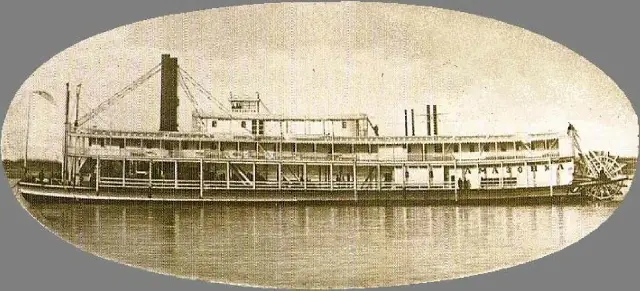
The first “American steamship” on the Volga “Amazon”. The main thing on it was the second upper passenger deck, where cabins of 1st and 2nd classes were located. 3rd class passengers were classified as “on deck” and were on the lower deck with “no seats”
It should be noted that our craftsmen turned out to be a great vessel: three decks, a total length of 58 meters, a width of 11 meters, moreover, with a flat bottom and, in addition, a record light weight. The Amazon's draft was only 0,71 meters, and with a full load on board - 400 passengers plus 393 tons of cargo - 1,2 meters! That is, it could approach even the shallowest piers, which was, of course, only to the advantage of its owners. The speed of the ship along the current was quite high - 20 km/h, and against the current - 10-12. The ship was originally designed as a cargo-passenger vessel, so a lot of space was allocated for cargo.
Passenger cabins were on the second deck. On the bottom there were two boilers and a two-cylinder steam engine. Moreover, the boilers, as on American ships, were located at the bow, and the engine was at the stern, and they were connected by long steam lines. This somewhat reduced its efficiency, but it freed up the entire middle part of the deck for cargo, and in addition, improved the weight distribution of the hull.
The wide paddle wheel was located at the back, but the rudders, four of them, were installed in front of it. This arrangement of the rudders improved the maneuverability of the ship in shallow water, which was again very important for the Volga. And, by the way, in the shallow-water season of 1883, the Amazon performed excellently. The result was logical: in the following years, Zeweke’s company ordered several of these steamships at once, which the Volgars, however, nicknamed “goats” for the two pipes spaced along the sides.
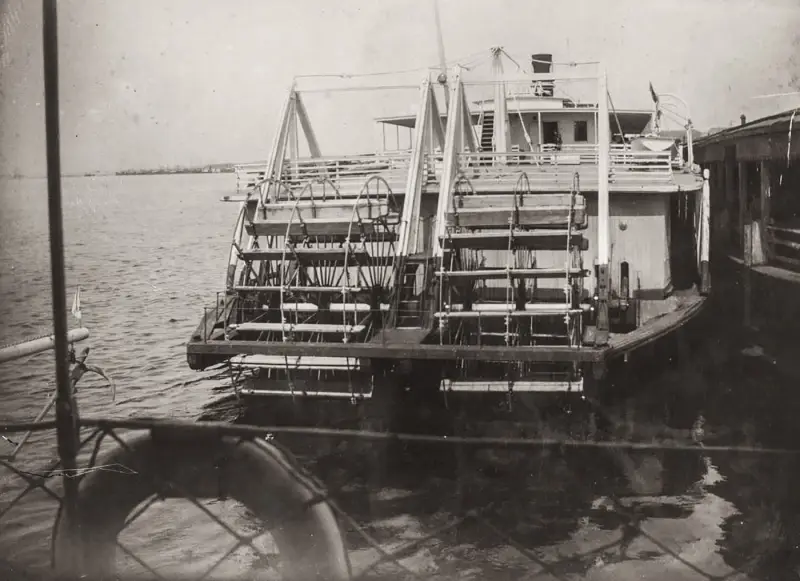
Sometimes, to increase maneuverability, the rear wheel was made double, with each of them independently driven
For passengers of 1st and 2nd classes, luxuriously decorated cabins were equipped; they had buffets with a rich selection of a wide variety of drinks and even hot dishes. For lovers of reading, there were libraries on board where the latest newspapers and magazines were delivered, and there was even a grand piano in the common salon! According to the rules, passengers of these two classes were allowed to disembark “on demand” outside the schedule, that’s how! Moreover, if there was no pier on the shore, and the passenger absolutely needed to get off, then the captain was obliged to take him ashore on a boat and only after that continue his journey.
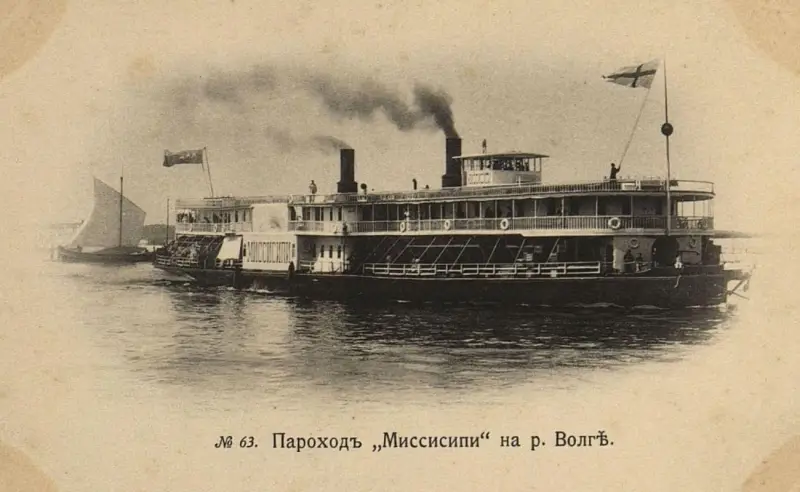
Since Seeweke's steamships were built of wood, they did not last long. Then they began to be replaced by ships with a metal hull. The paddle wheels were placed on their sides, and the pipes were placed one after the other, so that their silhouette changed greatly. But the old names of the ships were retained. The photo shows the updated steamship "Mississippi"
Like their American counterparts, Seeweke's steamships on the Volga also carried bales of cotton on deck, which was the cause of the fire on board the Alphonse Seeweke, launched in 1885. And this is how one of the eyewitnesses who survived described this disaster:
First of all, the middle part of the ship burned down (dining room, buffet, sailors' quarters), and the fire began to spread in two opposite directions: towards the stern and bow; as a result, the passengers were separated by an insurmountable barrier. The entire small group of passengers who came running to the bow, where the ship buried itself in the shore, managed to escape, since the depth was insignificant (waist-deep). The rest, who rushed to the stern, had to throw themselves into the water at the wheels of the steamer, located in the stern, where it was deep. The wheels did not stop working, so that many were pulled under them by the force of the current and the rotation of the water. About six o’clock the steamship “Provorny” of the “Airplane” company approached from above, and the “Nayad” of the same company from below, from which they lowered boats and began to rescue people in the water.”
(“World Illustration”, 1893, volume 50).
A message about a fire on the ship also appeared in local newspapers. Thus, the newspaper “Nizhny Novgorod Provincial Gazette” dated June 23, 1893 (No. 25) wrote in detail that on board the steamer “Alphonse Zeveke”, which was sailing from Rybinsk to Nizhny Novgorod with passengers and cargo on board, at six o’clock in the evening the fire. At a distance of 4-5 miles they extinguished it on their own, but they had little success.
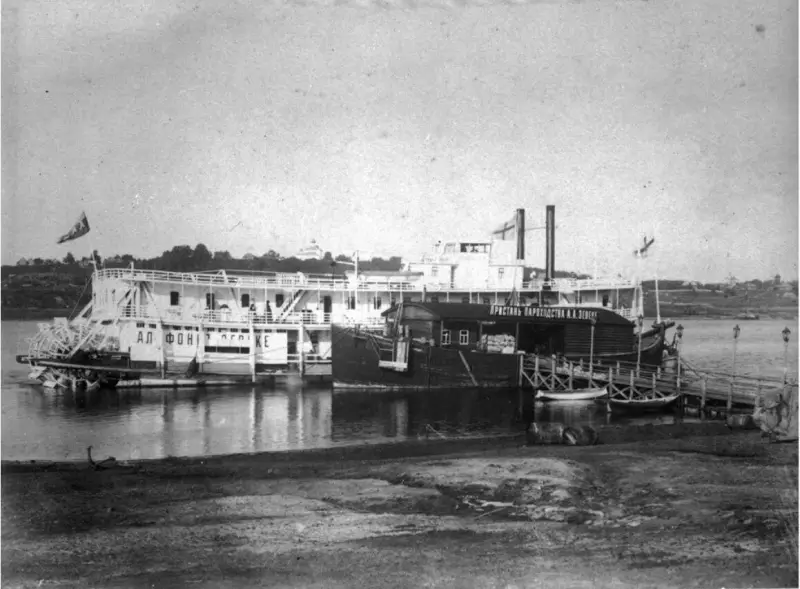
The steamer "Allons Seeweke" being loaded shortly before the fire
As a result of the fire, the steamer, stuck to the shore, burned to the ground. All that remained of it was a steam engine, two pipes and a paddle wheel. There were about 70 passengers on board, but exactly how many of them died is unknown. It is believed that half of them survived.
It must be said that the scale of the disaster in this case was not comparable to the Sultana disaster, but this was the first such case on the Volga, and, of course, they talked a lot about it. There was also a lot of talk about the fact that the ship’s death was facilitated by the fact that it was built entirely of wood. To some extent, this led to the fact that new steamships on the Volga began to be built from iron, although the passenger cabins were still made of wood. For some time, people were afraid to sail on Zeveke's steamships, but then skillful advertising and lower tariffs did their job, and his steamships again became a popular type of Volga river transport.
Information